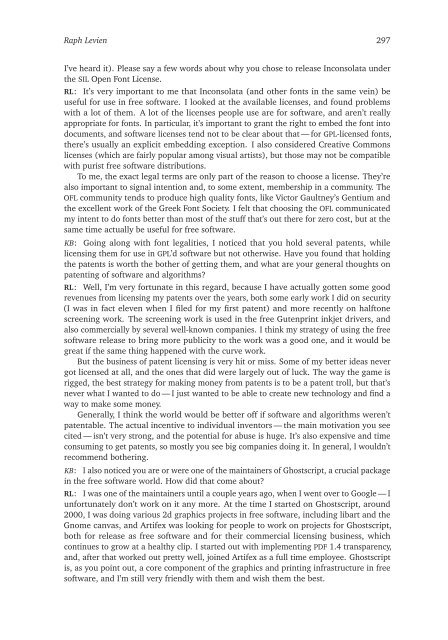Raph Levien - TUG
Raph Levien - TUG
Raph Levien - TUG
You also want an ePaper? Increase the reach of your titles
YUMPU automatically turns print PDFs into web optimized ePapers that Google loves.
<strong>Raph</strong> <strong>Levien</strong> 297<br />
I’ve heard it). Please say a few words about why you chose to release Inconsolata under<br />
the SIL Open Font License.<br />
RL: It’s very important to me that Inconsolata (and other fonts in the same vein) be<br />
useful for use in free software. I looked at the available licenses, and found problems<br />
with a lot of them. A lot of the licenses people use are for software, and aren’t really<br />
appropriate for fonts. In particular, it’s important to grant the right to embed the font into<br />
documents, and software licenses tend not to be clear about that — for GPL-licensed fonts,<br />
there’s usually an explicit embedding exception. I also considered Creative Commons<br />
licenses (which are fairly popular among visual artists), but those may not be compatible<br />
with purist free software distributions.<br />
To me, the exact legal terms are only part of the reason to choose a license. They’re<br />
also important to signal intention and, to some extent, membership in a community. The<br />
OFL community tends to produce high quality fonts, like Victor Gaultney’s Gentium and<br />
the excellent work of the Greek Font Society. I felt that choosing the OFL communicated<br />
my intent to do fonts better than most of the stuff that’s out there for zero cost, but at the<br />
same time actually be useful for free software.<br />
KB: Going along with font legalities, I noticed that you hold several patents, while<br />
licensing them for use in GPL’d software but not otherwise. Have you found that holding<br />
the patents is worth the bother of getting them, and what are your general thoughts on<br />
patenting of software and algorithms?<br />
RL: Well, I’m very fortunate in this regard, because I have actually gotten some good<br />
revenues from licensing my patents over the years, both some early work I did on security<br />
(I was in fact eleven when I filed for my first patent) and more recently on halftone<br />
screening work. The screening work is used in the free Gutenprint inkjet drivers, and<br />
also commercially by several well-known companies. I think my strategy of using the free<br />
software release to bring more publicity to the work was a good one, and it would be<br />
great if the same thing happened with the curve work.<br />
But the business of patent licensing is very hit or miss. Some of my better ideas never<br />
got licensed at all, and the ones that did were largely out of luck. The way the game is<br />
rigged, the best strategy for making money from patents is to be a patent troll, but that’s<br />
never what I wanted to do — I just wanted to be able to create new technology and find a<br />
way to make some money.<br />
Generally, I think the world would be better off if software and algorithms weren’t<br />
patentable. The actual incentive to individual inventors — the main motivation you see<br />
cited — isn’t very strong, and the potential for abuse is huge. It’s also expensive and time<br />
consuming to get patents, so mostly you see big companies doing it. In general, I wouldn’t<br />
recommend bothering.<br />
KB: I also noticed you are or were one of the maintainers of Ghostscript, a crucial package<br />
in the free software world. How did that come about?<br />
RL: I was one of the maintainers until a couple years ago, when I went over to Google — I<br />
unfortunately don’t work on it any more. At the time I started on Ghostscript, around<br />
2000, I was doing various 2d graphics projects in free software, including libart and the<br />
Gnome canvas, and Artifex was looking for people to work on projects for Ghostscript,<br />
both for release as free software and for their commercial licensing business, which<br />
continues to grow at a healthy clip. I started out with implementing PDF 1.4 transparency,<br />
and, after that worked out pretty well, joined Artifex as a full time employee. Ghostscript<br />
is, as you point out, a core component of the graphics and printing infrastructure in free<br />
software, and I’m still very friendly with them and wish them the best.

















